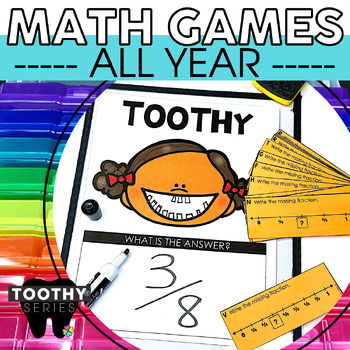3rd Grade Math Review Games, Centers, Activities, Task Cards - Toothy® Bundle
- Zip
What educators are saying
Description
Have you heard of Toothy® yet?! Toothy® task kits are highly engaging task card math games or math centers that allow students to practice math skills and answer questions in a fun, motivating way. The answers on the back of the math task cards make the activity self-paced and self-correcting.
Teach the rules for Toothy® once at the beginning of the year, then simply switch out the topic each week and use the activity all year!
Toothy® Task Kits - an original idea from Angie Olson at ©Lucky Little Learners, LLC.
⭐️DOWNLOAD THE PREVIEW FILE TO SEE THIS RESOURCE IN DETAIL⭐️
You can read all about Toothy Task Kits here:
Toothy Task Kits Blog Post
How to Prep Toothy Task Kits
Toothy Task Kits are a great option for your students as centers, math games, early finishers, or even morning work. The Toothy mats make these activities highly engaging! The answers on the back of the math task cards allow for these activities to be self-paced and self-correcting.
MATH SKILLS INCLUDED:
- Place Value- value of underlined digit (2-digit, 3-digit, & 4-digit)
- Comparing Numbers (3-digit & 4-digit)
- Making Numbers (given 3 digits make greatest & least value)
- Mastery Number (given ones, tens, & hundreds)
- Rounding to Nearest 10, 100, and 1,000
- 2-Digit Subtraction with & without Regrouping (vertical & horizontal)
- 2-Digit Addition with & without Regrouping (vertical & horizontal)
- 3-Digit Subtraction with & without Regrouping (vertical & horizontal)
- 3-Digit Addition with & without Regrouping (vertical & horizontal)
- Story Problems (addition)
- Story Problems (subtraction)
- US Money
- Canadian Money
- Australian Money
- Time (to the nearest 5 min)
- Time (to the nearest 1 min)
- Story Problems (time)
- Elapsed Time
- Base Ten Blocks (2-digit, 3-digit, & 4-digit)
- Expanded Form (2-digit, 3-digit, & 4-digit)
- Determine Unknown Number (multiplication)
- Determine Unknown Number (division)
- Multiplication Facts (1-digit & 2-digit)
- Division Facts
- Arrays
- Repeated Addition
- Story Problems (multiplication)
- Story Problems (division)
- Patterns on an Addition Table
- Patterns on a Multiplication Table
- Fractions of a Shape
- Fractions on a Number Line
- Equivalent Fractions
- Comparing Fractions
- Measurement of Liquid Volumes (cups, liters, & gallons)
- Measurement of Masses of Objects (grams & kilograms)
- Graphing
- Area
- Perimeter
- Story Problems (perimeter & area)
- Geometry (shapes, categories, & attributes)
- Partitioning Shapes
EACH MATH KIT INCLUDES:
-27 math task cards
-27 answer cards
-12 Toothy mats (boy & girl)
-container labels for each skill set(boy & girl)
-container label for the large container/organizer
-skill helper sheets for each skill set
-optional recording sheet
-directions
-prep suggestions
ALL TOOTHY IMAGES ARE CUSTOM & CREATED SPECIFICALLY FOR THESE TASK KITS ONLY
HOW TO PLAY:
Each partner gets a Toothy mat and dry erase marker. Students will take turns choosing a card. Each student who is playing the game will solve the problem on their Toothy mat or dry erase board. When all who are playing have answered the question, they compare their answers and then turn the card over to check to see if their answer is correct. Those who have a correct answer get to draw a tooth in Toothy’s mouth on their mat. If the student’s answer is incorrect, they do not draw a tooth and those who got the answer correct must explain how they got to the correct answer. Then the next student draws the next card and the process is repeated. The game is over once all 27 cards have been answered. The student with the most teeth in Toothy’s mouth is the winner of the game.
Please download the preview file to take a closer look at what is provided in this resource.
We also have Toothy Bundles for other skills!
- Kindergarten Math
- Kindergarten ELA
- 1st Grade Math
- 1st Grade Reading
- 1st Grade Phonics
- 1st Grade Social Emotional Learning
- 2nd Grade Math
- 2nd Grade Phonics
- 2nd Grade Reading
- 2nd Grade Grammar
- 2nd Grade Science
- 2nd Grade Social Studies
- 2nd Grade Social Emotional Learning
- 3rd Grade Math
- 3rd Grade Reading
- 3rd Grade Grammar
- Animal Toothy® Mats
- Holiday Toothy® Mats
▼▼▼▼▼▼▼▼▼▼▼▼▼▼▼▼▼▼▼▼▼▼▼▼▼▼▼▼▼▼▼▼▼▼▼▼▼▼▼▼▼▼▼▼
If you would like to get updates on NEW and CURRENT resources...
►SIGN UP to receive weekly email freebies!
►FOLLOW me on Teachers Pay Teachers!
►FOLLOW the Lucky Little Learners Blog!
▼▼▼▼▼▼▼▼▼▼▼▼▼▼▼▼▼▼▼▼▼▼▼▼▼▼▼▼▼▼▼▼▼▼▼▼▼▼▼▼▼▼▼▼
Copyright © Lucky Little Learners, LLC.
All rights reserved by author.
Permission to copy for single classroom use only.
Electronic distribution limited to single classroom use only.
Not for public display.
If you have any questions about this resource, please contact me at customerservice@luckylittlelearners.com





